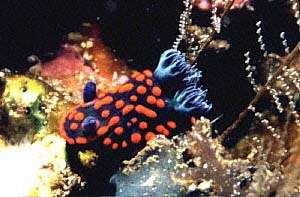
Nembrotha spp?
Order: NUDIBRANCHIA
Suborder: DORIDINA
Family: Polyceridae
Subfamily: Nembrothinae
PHOTO
UPPER: Negros Is, Philippines. Size: smaller than 1 cm, depth 9m.
LOWER LEFT: Negros Is, Philippines, dive site called "Dauin", size 15mm, depth 7m, nightdive.
LOWER RIGHT: Negros Is, Philippines, dive site called "Sara's Place", size 4 cm, depth 14 m.
PHOTOS: Erwin Koehler.
These three animals were photographed by Erwin Koehler, at Negros Is, Philippines, Oct-Nov 1998. I am not sure if they are all the same species. They all have similarities to two species, Nembrotha? rubroocellata and Nembrotha rubropapulosa described by Bergh (1905) in the report of the Siboga Expedition, but both those names almots certainly refer to Roboastra gracilis. Further photos accompany Erwin's messages below. Any ideas welcome.
Some messages on this page identified as Nembrotha guttata and moved to that page ... July 2001.
.jpg)
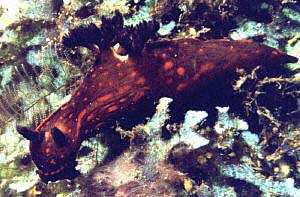
Rudman, W.B., 1999 (January 5) Nembrotha spp? [In] Sea Slug Forum. Australian Museum, Sydney. Available from http://www.seaslugforum.net/find/nembsp3
Related messages
Adult & Juvenile (?) Nembrotha
May 14, 2010
From: Stewart L. Sy
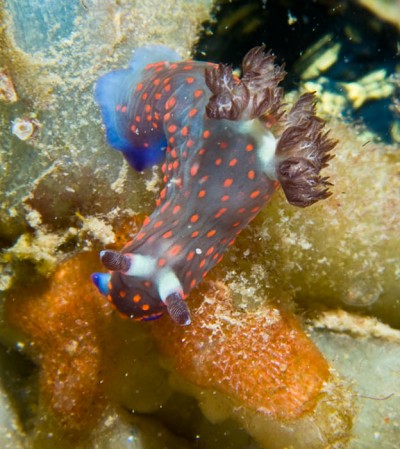
Hi Dr. Rudman
I photographed this nudibranch in the Philippines in January of 2008. The dive guide said that he's only seen it on this particular coral, and I'm guessing that the inset photo is a juvenile. I've combed through my id book 1001 Nudibranchs and I couldn't find it. All I can maybe say is that is a dorid. ??
Locality: Manila Channel, Puerto Galera, 15 meters, give or take, Oriental Mindoro, Philippines, 12 Jan 2008, On Soft Coral. Length: larger, 1", smaller, 5mm. Photographer: Stewart L. Sy.
Just hoped you'd satisfy my curiosity.
Much thanks!
Stewart Sy
stewart@stewartsy.com
Sy, S. L., 2010 (May 14) Adult & Juvenile (?) Nembrotha. [Message in] Sea Slug Forum. Australian Museum, Sydney. Available from http://www.seaslugforum.net/find/23626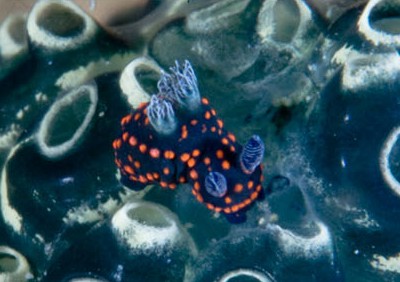
Dear Stu,
I discuss the animal in your upper photo in message #21144 and this group of reddish spotted species more generally on the Nembrotha spp Fact Sheet.
I am pretty sure these two are different species. I am afraid we can't say much more about them at present.
Best wishes,
Bill Rudman
Re: A red-spotted Nembrotha
January 13, 2009
From: Ken Tucker

Concerning message #21144:
Here is another of the same 'species' from Sulawesi.
Locality: Lembeh Strait, 18 metres, North Sulawesi, Indonesia, Celebes Sea, 27 Dec 08. Length: 3 mm. Photographer: Ken Tucker.
Best wishes
Ken Tucker
kc@kilili.com
Tucker, K., 2009 (Jan 13) Re: A red-spotted Nembrotha. [Message in] Sea Slug Forum. Australian Museum, Sydney. Available from http://www.seaslugforum.net/find/22129Thanks Ken,
I can't see a quick answer for this group, but every new photo helps to clarify the range of variation.
Best wishes,
Bill Rudman
Re: Nembrotha livingstonei from South Africa
March 20, 2008
From: David Abecasis
Concerning message #21114:
Hi Bill,
Couldn't this be the same species that I photographed in Northern Mozambique?
Regards,
David Abecasis
davidbecas@netcabo.com
Abecasis, D., 2008 (Mar 20) Re: Nembrotha livingstonei from South Africa. [Message in] Sea Slug Forum. Australian Museum, Sydney. Available from http://www.seaslugforum.net/find/21461Dear David,
I knew I had seen a sphoto of an animal like Colin's recently. Yes this well illustrates my point that we still have a few things to sort out with these animals with reddish spots. For consistency I'll move his message to the Nembrotha spppage
Best wishes,
Bill Rudman
Nembrotha livingstonei from South Africa
March 19, 2008
From: Colin Ogden
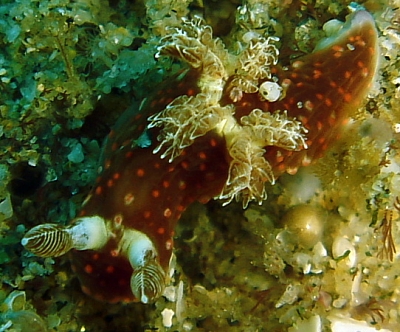
Note added 20 March 2008: Have moved to Nembrotha spp page - see message #21461.
Hi Bill,
I notice you don't have a report on the forum for a Nembrotha livingstonei from South Africa, though Gosliner does have it in his book. Here is a picture of one I found yesterday, and also a pic of a juvenile I found 2 years ago. It was only about 3 mm in size so the quality is not so good. The structure it was sitting on I believe was its food source (as a juvenile), because I found another on on the same structure a couple of months later. Would a nudibranch change its food source during its development?
Locality: Sodwana Bay, 14 metres, South Africa, Indian, 11 November 2007, reef. Length: 35 mm. Photographer: Colin Ogden.
Regards
Colin
scubaco@iafrica.com
Ogden C. M., 2008 (Mar 19) Nembrotha livingstonei from South Africa. [Message in] Sea Slug Forum. Australian Museum, Sydney. Available from http://www.seaslugforum.net/find/21114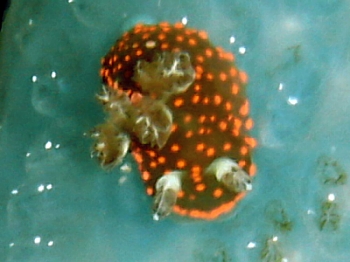
Dear Colin,
I think this is probably N. livingstonei although I woud normally expect to see a white cross between the rhinophores, or some traces of one. Perhaps in the western Indian Ocean that part of the colour pattern is lost. I think we still have a bit to do in sorting out the red-spotted species so keep your eyes out for other variations.
Concerning species changing food as they develop. Once a species settles from the plankton they begin feeding on their adult food. In many cases it is chemicals from the adult food which trigger the settlement behaviour in the swimming planktonic larvae. Obviously in species where the adults eat whole polyps, the juveniles can't do the same, but they seem to eat other parts of the colony, rather than a different food. In species of Nembrotha we would expect them to eat one or more ascidians.
Best wishes,
Bill Rudman
A red-spotted Nembrotha and N. yonowae
March 7, 2008
From: David Abecasis
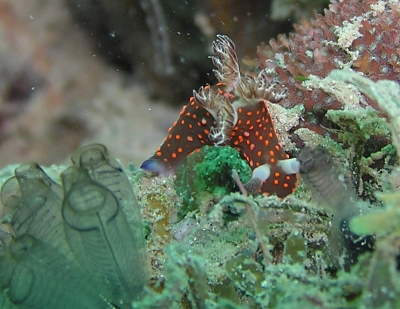
Hello Bill,
I found this small nudibranch on one of my last dives. I am having a hard time to ID it. Do you have any idea?
Locality: Quirimbas archipelago, 8 meters, Mozambique, Indian Ocean, 29 October 2007, Coral reef. Length: ~15mm. Photographer: David Abecasis.
Best regards,
David Abecasis
davidbecas@netcabo.pt
Abecasis, D., 2008 (Mar 7) A red-spotted Nembrotha and N. yonowae. [Message in] Sea Slug Forum. Australian Museum, Sydney. Available from http://www.seaslugforum.net/find/21144
Dear David,
My best answer to your question about whether I can identify this animal is 'yes and no'. If you look at the Nembrotha spp page you will see a group of reddish spotted animals I haven't been able to put a name on, and many of them [see #19534], but not all of them, seem to be the same species as yours. I have kept them separate from the ones I have identified as Nembrotha guttata. But I am not even sure about that species and have some separated as Nembrotha cf. guttata. Some animals have a distinct orange cap to the rhinophore club and an orange margin around the rhinophore sheath while others don't. Some, like yours, have white rhinophore sheaths and white edging to the gills etc etc.
I am afraid I don't think the recent Nembrotha paper (Pola et al, 2008) has resolved this problem and as they say in their discussion "the internal anatomy of the species complex nigerrima-cristata-yonowae is very similar" so we are apparently not likely to find a simple answer in the basic anatomy.
To complicate matters there is also a nomenclatural problem - that is a question about what names we should use as well as how many species there are and how we should identify them. Pola et al, propose we replace Nembrotha guttata Yonow, 1993 with N. yonowae Goethel & Debelius, 1992 considering them both to be the same. When Yonow described her species she deliberately stated that the description of N. yonowae was so poor, and lacked a type specimen, and so was unable to be distinguished from other red-spotted species. Even if at that time the International Code did not require there to be a type specimen deposited, if there is no available specimen how do you check to see just which red-spotted species they were describing? As you can see here, there are probably more than one species involved. So on those grounds she described her species as distinct. In Pola et al there are three colour photos identified as N. yonowae, one of which (Fig 14A) looks like what I am calling N. guttata, but the other two (Fig 14B,C) look more like your animal. They also have another photo (Fig 14 D) of a red-spotted animal which they identify as Nembrotha sp. and which looks like others on my miscellaneous red-spotted page. I mention this because it suggests the author's are not clear themselves on just what constitutes what they call Nembrotha yonowae. If that is the case it seems premature to synonymise that name and N. guttata as they might both turn out to be valid species.
At the moment I am trying to get a copy of the Goethel & Debelius description of N. yonowae. It was published in a non-scientific journal and I have until now been unable to find a copy. So basically I can't identify your animal at present. As Pola et. al say "further morphological and molecular studies need to be done to fully resolve these issues"
- Pola, M., Cervera, J.L. and Gosliner, T.M. 2008. Revision of the Indo-Pacific genus Nembrotha (Nudibranchia: Dorididae: Polyceridae), with description of two new species. Scientia Marina 72(1): 145-183.
Best wishes,
Bill Rudman
Nembrotha spp, from East Timor
February 28, 2007
From: Brian Francisco
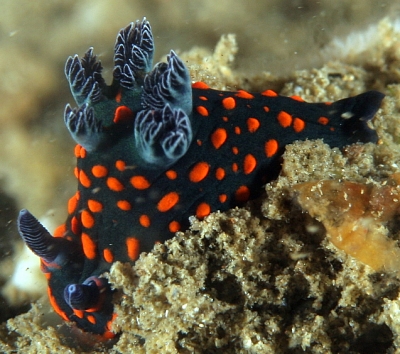
Hi Bill
I think this is Nembrotha spp., similar to Erwin Koehler's photograph in message #441.
Locality: Tasi Toly, 18 meters , East Timor, Banda Sea, 24 February 2007, sandy slope. Length: 8 mm. Photographer: Brian Francisco.
Brian
francisco.brian@gmail.com
Francisco, B., 2007 (Feb 28) Nembrotha spp, from East Timor. [Message in] Sea Slug Forum. Australian Museum, Sydney. Available from http://www.seaslugforum.net/find/19534
Dear Brian,
Yes it certainly looks the same. There still seems to be some work needed on these red-spotted nembrothids.
Best wishes,
Bill Rudman
Re: Two-gilled Slug?
December 11, 2006
From: Joy Go
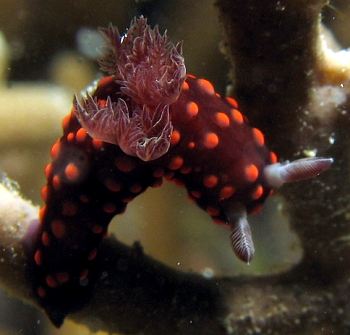
Concerning message #18711:
Dear Bill,
Attached is another photo of the subject, Nembrotha, showing the gills. I'm also trying to figure out from the photo if it has 2 or 3 gills.
Regards,
Joy
joygo8@gmail.com
Go, J.D., 2006 (Dec 11) Re: Two-gilled Slug?. [Message in] Sea Slug Forum. Australian Museum, Sydney. Available from http://www.seaslugforum.net/find/18973Dear Joy,
I guess this is one we are not going to be able to answer.
Best wishes,
Bill Rudman
Two-gilled Slug?
December 1, 2006
From: Joy D. Go
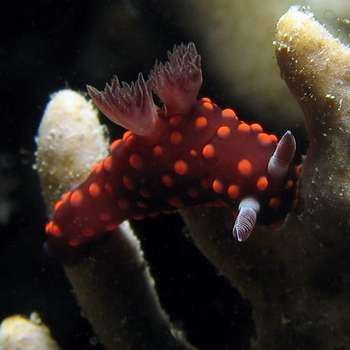
Dear Bill,
A friend referred me to your site. Can you please help me identify the slug on this photo that I took a week ago? It seems to have two gills.
Locality: Baul Island, Guiuan, 10-15 meters, Philippines, Leyte Gulf, 21 November 2006, Wall. Length: Approximately 1.5 to 2 inches. Photographer: Joy D. Go.
I haven't found this on any of my references, so any help in identification would be appreciated.
Best regards,
Joy D. Go
joygo8@gmail.com
Go, J.D., 2006 (Dec 1) Two-gilled Slug?. [Message in] Sea Slug Forum. Australian Museum, Sydney. Available from http://www.seaslugforum.net/find/18711Dear Joy,
This is unnamed species of Nembrotha which I am clustering with a number of similarly coloured red/orange-spotted species. Yours is almost certainly the one in a recent message [#18238] which has 3 large branched gills. Your animal, apparently with only 2 gills, is either damaged, or one of its gills is obscured in your photo.
Best wishes,
Bill Rudman
Re: Nembrotha from Philippines
November 8, 2006
From: Ugo Gaggeri
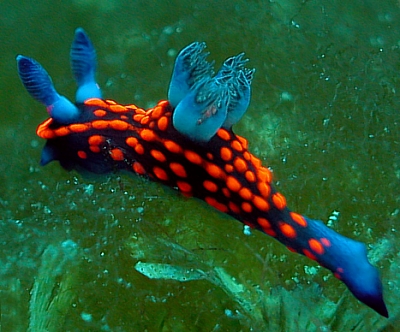
Concerning message #441:
Here is another orange spotted Nembrotha that I found in Bunaken Park.
Locality: Bunaken Park, about 20 meters, Indonesia, Celebes Sea, end of December 2006. Length: about 15 mm. Photographer: Ugo Gaggeri.
Ugo Gaggeri
ugogaggeri@hotmail.com
Gaggeri, U., 2006 (Nov 8) Re: Nembrotha from Philippines. [Message in] Sea Slug Forum. Australian Museum, Sydney. Available from http://www.seaslugforum.net/find/18238Dear Ugo,
Thanks very much. This is clearly the same animal as Erwin Koehler's photographed earlier [message #441]. From the shape of the gills it is definitely not a colour form of Roboastra gracilis.
Best wishes,
Bill Rudman
Polycerid from New Zealand
May 22, 2002
From: Gareth Jones

Hi Dr. Rudman.
Here is another puzzle from New Zealand. It was about 3mm long and seen at 8m. It was also from the Poor Knights Islands [north-eastern New Zealand].
Gareth.
rees@divenz.co.nz
Jones, G., 2002 (May 22) Polycerid from New Zealand. [Message in] Sea Slug Forum. Australian Museum, Sydney. Available from http://www.seaslugforum.net/find/6988Dear Gareth,
This is another interesting find. Almost certainly a tropical visitor. I am afraid these reddish spotted polycerids are a bit of a mess to idntify at present. Your animal look very like one in Stuart Hutchison's photos from Papua New Guinea. So if you want a label for it I am afraid 'polycerid sp' might be as far as I am willing to go at present.
Best wishes,
Bill Rudman
Red-spotted Nembrotha? from Exmouth, WA
April 11, 2001
From: Kirk Gibson
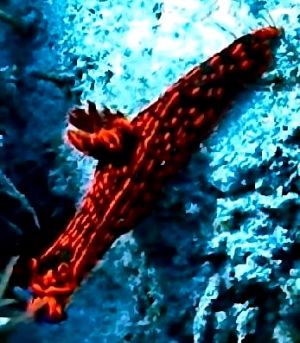
Dear Bill,
This nudibranch was photographed by me in Exmouth, northern Western Australia in 14m of water. Length 10cm
Kirk Gibson
captainkirk@wn.com.au
Gibson, K., 2001 (Apr 11) Red-spotted Nembrotha? from Exmouth, WA. [Message in] Sea Slug Forum. Australian Museum, Sydney. Available from http://www.seaslugforum.net/find/4115Dear Kirk,
I am not sure whether this is a species of Nembrotha or not. There appear to be a number of similarly coloured species which need sorting out. I have placed them together on a red-spotted Nembrotha page.
Best wishes,
Bill Rudman
Polycera from Papua New Guinea
March 22, 2000
From: Stuart Hutchison
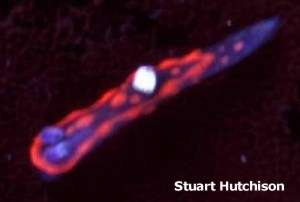
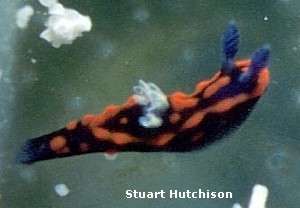
Dear Bill,
Here two tiny 4mm long subjects photographed some miles apart in March/April, 1999 in Milne Bay, PNG. Very enlarged and underdeveloped image. Both were found in about 15m of water and were photographed at 1:1 then digitally enlarged for you. The grains of sand give away its size!
Regards,
Stuart Hutchison
hutchco@tpg.com.au
Hutchison, S., 2000 (Mar 22) Polycera from Papua New Guinea. [Message in] Sea Slug Forum. Australian Museum, Sydney. Available from http://www.seaslugforum.net/find/1757Dear Stuart,
These are almost certainly juveniles. They are one of a group of orange-spotted nembrothid species I have grouped on one page more for convenience than belief they are a single species. I suspect your animals are most like the Top Right photo at the Top of the Page.
We will need some animals to look at before they can be sorted out.
Best wishes,
Bill Rudman.
Nembrotha from Philippines
January 5, 1999
From: Erwin Koehler

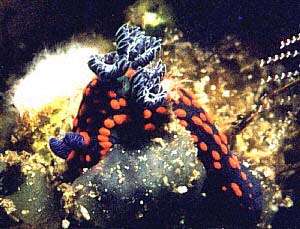
Dear Bill,
here is the next one from Negros Is, Philippines, Oct-Nov 1998. Size: less than 1 cm, depth 9m.
Erwin
E.Koehler@deutschepost.de
Koehler, E., 1999 (Jan 5) Nembrotha from Philippines. [Message in] Sea Slug Forum. Australian Museum, Sydney. Available from http://www.seaslugforum.net/find/441Erwin,
It seems to be feeding on the blue-green ascidian it is sitting on. Concerning identification - have a look at my comment at the top of the page.
Bill Rudman
And another Nembrotha from Philippines
January 5, 1999
From: Erwin Koehler


Dear Bill
A third Nembrotha from Negros Is, Philippines, dive site called "Sara's Place", size 4 cm, depth 14 m.
Erwin
E.Koehler@deutschepost.de
Koehler, E., 1999 (Jan 5) And another Nembrotha from Philippines. [Message in] Sea Slug Forum. Australian Museum, Sydney. Available from http://www.seaslugforum.net/find/443Erwin,
This is probably a third species.
Bill Rudman.
